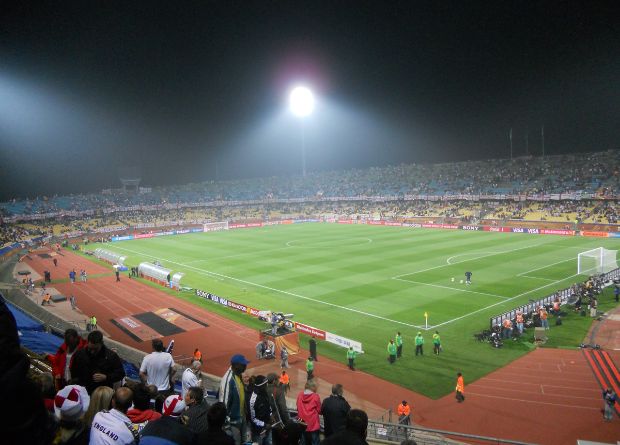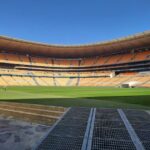The Royal Bafokeng Sports Palace is a multipurpose stadium located in Phokeng, South Africa. It is the home stadium of the Platinum Stars Football Club and has a seating capacity of 44,530 spectators. The stadium has been used for various sporting events, including the 2010 FIFA World Cup.

The architectural design of the Royal Bafokeng Sports Palace is inspired by the traditional African amphitheaters. The stadium has an oval shape with a unique roof structure that resembles a calabash. The roof is made of a translucent material that allows natural light to penetrate the stadium, creating a unique atmosphere for spectators. The stadium also has a state-of-the-art sound system that provides excellent acoustics for music concerts and other events.
The construction of the Royal Bafokeng Sports Palace was completed in 1999, and the stadium has undergone several renovations since then. In 2009, the stadium was expanded to increase its seating capacity and improve its facilities. The stadium has a swimming pool, an athletics track, tennis courts, netball courts, basketball courts, and a fitness center. The seating arrangements are designed to provide excellent views of the field from all angles, ensuring that every spectator has a great view of the action.
Key Takeaways
- The Royal Bafokeng Sports Palace is a multipurpose stadium located in Phokeng, South Africa, with a seating capacity of 44,530 spectators.
- The stadium’s architectural design is inspired by traditional African amphitheaters and has a unique roof structure made of a translucent material.
- The stadium has undergone several renovations since its construction in 1999 and has excellent facilities, including a swimming pool, athletics track, and fitness center.
Architectural Design

Conceptualization
The Royal Bafokeng Sports Palace was conceptualized as a state-of-the-art stadium with a modern design that would meet the needs of both players and spectators. The conceptualization phase focused on creating a stadium that could host international sporting events, while also serving as a multipurpose venue for concerts and other events.
Blueprints and Planning
The design of the stadium was a collaborative effort between two architectural firms: WATERSTON WEYER and ROON Architects and BSP Architects. The original design by WATERSTON WEYER and ROON received an award of excellence. The stadium underwent renovations in 2010 by BSP Architects in preparation for the Soccer World Cup. The renovations expanded the stadium’s capacity from 39,000 to 45,000.
The stadium’s unique design features a circular shape, with a partially covered seating area that provides shade and protection from the elements. The seating plan is arranged in a bowl shape, with the pitch at the center. The design offers unobstructed views of the pitch from every seat in the stadium.
The stadium’s construction began in 1996 and was completed in 1999. It is situated in Rustenburg, South Africa, and is owned by the Royal Bafokeng Nation. The stadium’s construction and design were inspired by the Bafokeng tribe’s rich history and culture.
The stadium’s interior design features a modern and sleek look, with state-of-the-art facilities for players and spectators. The stadium’s seating plan is arranged in a way that ensures that every seat in the stadium has an excellent view of the pitch.
In conclusion, the Royal Bafokeng Sports Palace’s architectural design is a testament to modern design and the Bafokeng tribe’s rich history and culture. The stadium’s design and construction were carefully planned and executed, resulting in a world-class sporting venue that can host international events and serve as a multipurpose venue for various events.
Construction Details

Groundbreaking Ceremony
The Royal Bafokeng Sports Palace was built in 1999 by the Royal Bafokeng Nation, a South African ethnic group. The groundbreaking ceremony was attended by the then President of South Africa, Thabo Mbeki, and other dignitaries. The stadium was designed by Waterston Weyer & Roon and later renovated in 2010 for the Soccer World Cup by BSP Architects.
Materials and Techniques
The construction of the Royal Bafokeng Sports Palace used advanced materials and techniques. The stadium’s foundation is made of reinforced concrete, and the roof is made of a lightweight steel structure covered with a membrane. The seating areas are made of precast concrete, and the field is made of natural grass.
Challenges and Solutions
The construction of the Royal Bafokeng Sports Palace faced several challenges. One of the biggest challenges was the location of the stadium, which is in an area with a high water table. This made it difficult to construct the foundation and required the use of specialized techniques to ensure stability.
Another challenge was the limited budget for the project, which required the use of cost-effective materials and techniques. The architects and engineers had to find creative solutions to ensure that the stadium was built to the highest standards while staying within budget.
Despite these challenges, the construction of the Royal Bafokeng Sports Palace was completed on time and within budget. The stadium has since hosted several high-profile events, including the 2010 FIFA World Cup.
Also, check: Inside Peter Mokaba Soccer Stadium: Construction Features Revealed
Seating Arrangements

Capacity and Layout
The Royal Bafokeng Sports Palace has a seating capacity of 44,530 and is built in a bowl shape to provide an unobstructed view of the field from all angles. The stadium features four stands: North, South, East, and West. The North and South stands are uncovered, while the East and West stands are partially covered.
The stadium’s seating layout is designed to accommodate different types of events, including soccer matches, concerts, and other sporting events. The seating is divided into three main categories: General seating, VIP seating, and Premium seating.
Accessibility Features
The Royal Bafokeng Sports Palace is designed to be accessible to all patrons, including those with disabilities. The stadium features wheelchair-accessible seating areas, as well as designated parking areas for patrons with disabilities. The stadium also has accessible restrooms and concession areas.
VIP and Premium Seating
The stadium offers VIP and Premium seating options for patrons who want to enjoy a more luxurious experience. The VIP seating area is located in the West Stand and includes access to a private lounge, premium seating, and exclusive food and beverage options.
The Premium seating area is located in the East Stand and offers a more exclusive experience than the General seating area. The Premium seating area includes wider seats with more legroom and access to premium food and beverage options.
In conclusion, the Royal Bafokeng Sports Palace is designed to provide a comfortable and enjoyable experience for all patrons. The stadium’s seating arrangements are designed to accommodate different types of events and provide options for patrons who want a more luxurious experience. The stadium’s accessibility features ensure that all patrons can enjoy the events held at the stadium.



